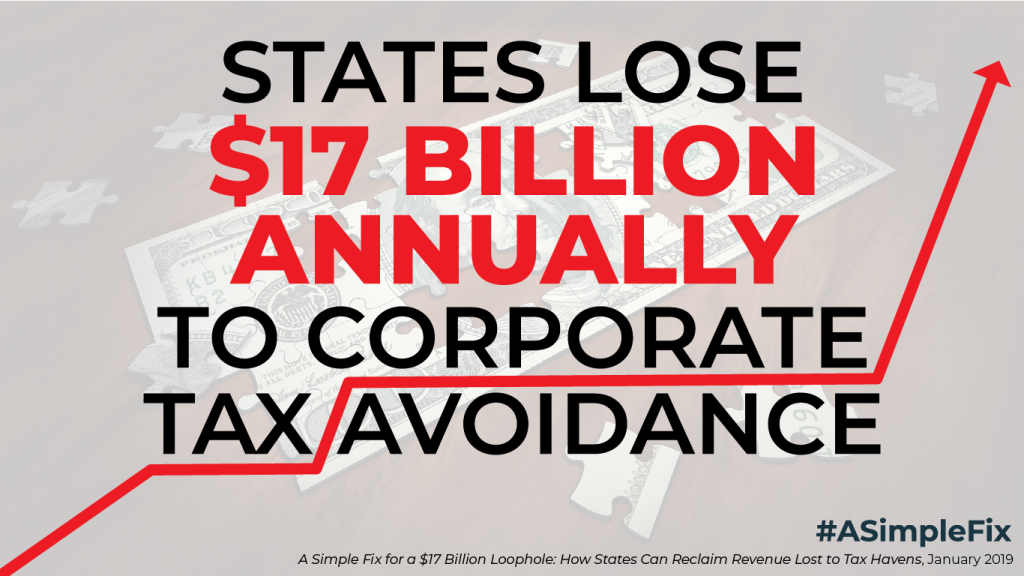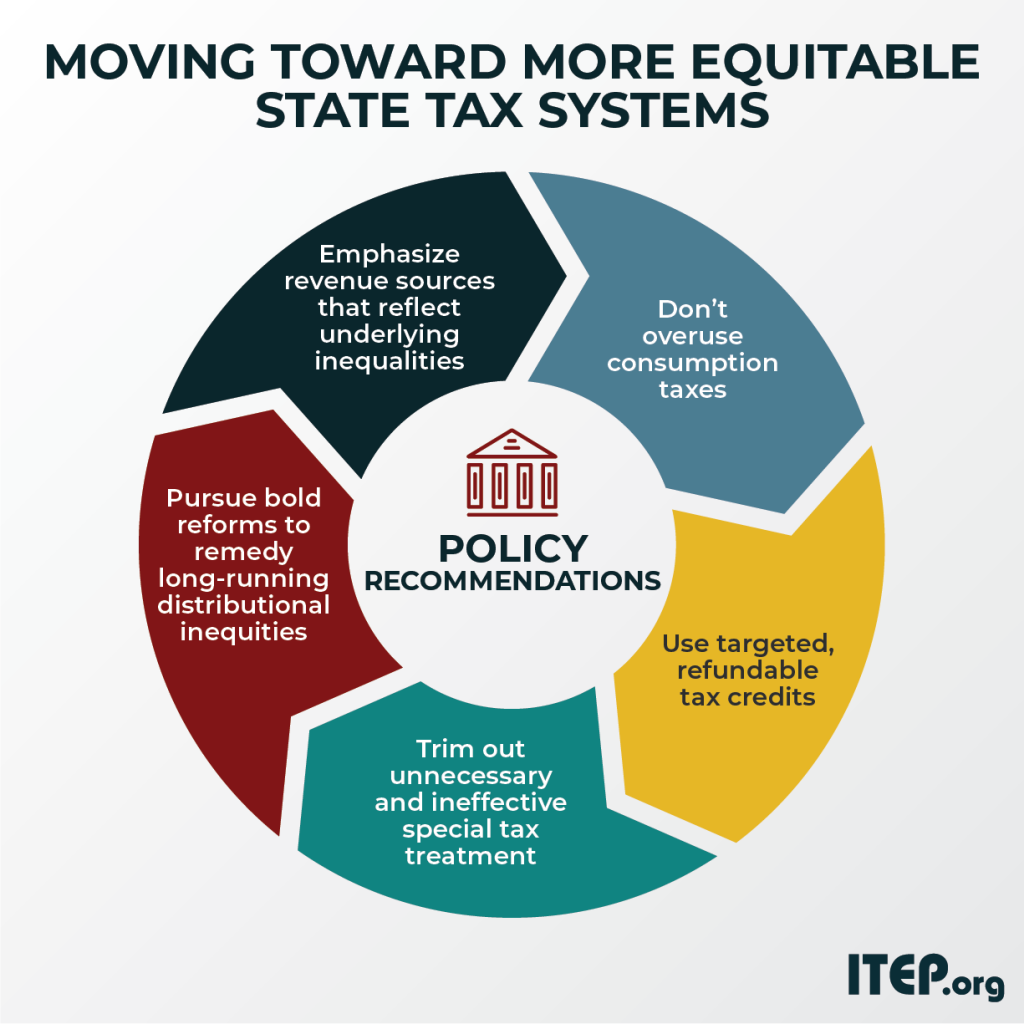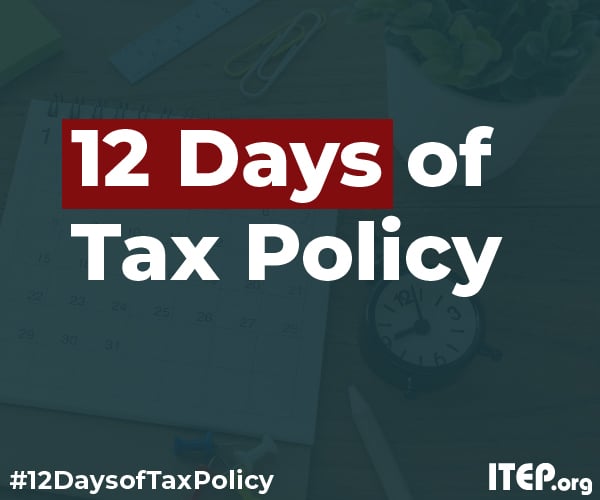
ITEP's Research Priorities
- 2025 tax debate
- Blog
- Cannabis Taxes
- Corporate Taxes
- Corporate Taxes
- Earned Income Tax Credit
- Education Tax Breaks
- Estate Tax
- Federal Policy
- Fines and Fees
- Immigration
- Income Taxes
- Inequality and the Economy
- ITEP Work in Action
- Local Income Taxes
- Local Policy
- Local Property Taxes
- Local Refundable Tax Credits
- Local Sales Taxes
- Maps
- News Releases
- Personal Income Taxes
- Property Taxes
- Property Taxes
- Publications
- Refundable Tax Credits
- Sales, Gas and Excise Taxes
- Sales, Gas and Excise Taxes
- SALT Deduction
- Select Media Mentions
- Social Media
- Staff
- Staff Quotes
- State Corporate Taxes
- State Policy
- State Reports
- States
- Tax Analyses
- Tax Basics
- Tax Credits for Workers and Families
- Tax Credits for Workers and Families
- Tax Reform Options and Challenges
- Taxing Wealth and Income from Wealth
- Trump Tax Policies
- Who Pays?
How States Can Help Shut Down Tax Havens by Cracking Down on Profit Shifting
January 17, 2019 • By Richard Phillips

A core problem with our corporate income tax laws at the federal and state levels is that they allow companies to use accounting gimmicks to shift significant amounts of their profits into low or zero-tax jurisdictions. Federal lawmakers had an opportunity to address this with the 2017 tax law, but they failed to do so, and, in fact, the law may incentivize more offshore tax avoidance. State lawmakers, however, can buck the federal trend and crack down on profit shifting themselves.
Who Pays and Why It Matters | MECEP Policy Insights Conference Keynote Address
January 16, 2019 • By Aidan Davis
States have broad discretion in how they secure the resources to fund education, health care, infrastructure, and other priorities important to communities and families. Aidan Davis with the Institute on Taxation and Economic Policy will offer a national perspective on state-level approaches to funding public investments and the implications of those approaches on tax fairness and revenue adequacy, and their economic outcomes. She’ll also provide insight on what’s in store for 2019 among the states.
Missouri Budget Project: Senate Tax Bills Provide Unfair Giveaways, Leave Communities Reeling
January 16, 2019
An analysis by the Institute on Taxation & Economic Policy found that 91% of the tax cut would flow to the wealthiest 20% of Missourians.
Maine Center for Economic Policy: The Prosperity Budget
January 15, 2019
Where State of Working Maine 2018 investigated the nature of work in the modern economy and made recommendations to reaffirm our values of fairness and respect in the workplace, the Prosperity Budget examines the opportunity to leverage state budget and tax policy to build a stronger economy where every Mainer has an equal opportunity to […]
Gov. Cuomo Has the Right Idea on How to Tax Recreational Cannabis
January 15, 2019 • By ITEP Staff
Following is a statement by Carl Davis, research director at the Institute on Taxation and Economic Policy, regarding the cannabis tax structure unveiled by New York Gov. Andrew Cuomo.
MassBudget: 14 Options for Raising Progressive Revenue
January 14, 2019
People in Massachusetts seek to live in communities that provide a high quality of life for their family and neighbors. We value good schools, police and fire protection, libraries and parks, smooth roads and reliable transit, and supports to help families struggling through tough times. A community’s day-to-day well-being and its long-term prosperity are built […]
Policy Matters Ohio: New Research Underlines Need to Overhaul State Tax Code
January 11, 2019
Ohio’s upside-down tax system takes an especially heavy toll on black and Latino residents. That’s the finding of new research from the Institute on Taxation & Economic Policy (ITEP), a national nonprofit research group with a sophisticated model of the tax system, that was released today by Policy Matters Ohio. Read more

New and returning policymakers have a tremendous opportunity to improve their constituents’ lives and their states’ economies through tax policy. This report distills the findings of “Who Pays?” into policy recommendations that can serve as a guide to new lawmakers, advocates, and others seeking to improve their state’s tax codes. It explains the importance of favoring taxes on income and wealth over taxes on consumption, the value of certain targeted tax benefits for families living in poverty, the need to abandon ineffective, unnecessary tax subsidies for high-income households, and the promise of bold new options for improving the regressive distributional…
How to Think About the 70% Top Tax Rate Proposed by Ocasio-Cortez (and Multiple Scholars)
January 8, 2019 • By Steve Wamhoff

The uproar deliberately steers clear of any real policy discussion about what a significantly higher marginal tax rate would mean. Her critics are mostly the same lawmakers who enacted a massive tax cut for the rich last year that was not debated seriously or supported by serious research. Meanwhile, multiple scholarly studies conclude a 70 percent top tax rate would be an optimal way to tax the very rich. Ocasio-Cortez has brought more attention to the very real need to raise revenue and do it in a progressive way.
Arizona Center for Economic Progress: Wrong Priorities: It Doesn’t Make Sense to Give a Tax Cut to the Rich While Arizona Asks Children in Public Schools to Wait
January 2, 2019
Arizona stands to gain $130 million to $230 million in General Fund revenues if it conforms the Arizona tax code to the federal tax changes enacted in 2017. Rather than directing those additional revenues to better prepare for the next economic downturn or toward increased investments in our public schools, SB1143 and HB2522 will direct […]

Sometimes policy developments move at a rapid-fire pace, so we’re taking time over the next 12 days to reflect on some of the most significant federal and state tax policy developments and/or tax policy analyses that happened this year.
Economic Progress Institute: Rhode Island Standard of Need
December 20, 2018
The RISN calculates a household budget for families with two young children, and for single adults. The no-frills budget includes the costs of housing, food, transportation, health care, child care and other necessities including clothing, toiletries and telephone service. The RISN also demonstrates how work supports like food assistance, tax credits, and child care and health care subsidies help close the gap between income and basic need expenses. By taking all of these factors into account, the RISN provides a more realistic measure of the economic security of Rhode Islanders than the federal poverty level.

It’s that time of year again. Members of Congress and the White House are negotiating the federal budget. Winter temperatures are unpredictable due to climate change. And news outlets, organizations and others are releasing end-of-year lists and the tax wonks at ITEP are joining the chorus. If you’re lucky enough to have some time off over the next couple of weeks or find yourself curling up on the couch this winter in need of a way to pass the time, the tax policy wonks at ITEP have compiled a winter reading/listening list that will appeal to wonks and non-wonks alike.
Voices for Utah Children: Response to Govenor’s Budget Recommendations FY2020
December 17, 2018
As a percent of income, 95% of Utah’s families pay more in sales and other local taxes than the top 5% of higher income families.
Georgia Budget & Policy Institute: Increase the State Tobacco Tax for Healthier Georgia
December 15, 2018
Georgia could raise more than $400 million a year to make critical investments for the health and well-being of Georgia residents by raising the cigarette tax by at least $1 per pack. Georgia has the third-lowest state cigarette tax rate out of the 50 states and the District of Columbia. At 37 cents per pack, it falls far below the national average of $1.72. Over the past decade, many states have increased tobacco tax rates as a way to raise new revenue while reducing smoking rates and the health care costs associated with smoking. Georgia has not increased its cigarette…
The Federal Estate Tax: An Important Progressive Revenue Source
December 6, 2018 • By ITEP Staff

For years, wealth and income inequality have been widening at a troubling pace. One study estimated that the wealthiest 1 percent of Americans held 42 percent of the nation’s wealth in 2012, up from 28 percent in 1989. Lawmakers have exacerbated this trend by dramatically cutting federal taxes on inherited wealth, most recently by doubling the estate tax exemption as part of the 2017 Tax Cuts and Jobs Act. Further, lawmakers have done little to stop aggressive accounting schemes designed to avoid the estate tax altogether. This report explains how the percentage of estates subject to the federal estate tax…
Housing for All? Developers Bulldoze Taxpayers in Affordable Housing Debate
December 4, 2018 • By Monica Miller

Affordable housing advocates across the nation are attempting to address the problem at the local level, but they often face political and community opposition. These challenges are currently playing out in Baltimore, which is turning into a case study in how the best-planned civic interventions run into tough road blocks when it comes to tax increases versus moneyed special interest who seek to block those tax increases.
New Mexico Voices for Children: The Cliff Effect: One Step Forward, Two Steps Back
November 29, 2018
This report focuses on the cliff effect that occurs with the loss of child care assistance for New Mexico families. Losing child care assistance is especially detrimental to families because the cost of child care is so high. High-quality child care costs more than tuition and fees at New Mexico’s 4-year public universities, so it is an expense that even middle-income families struggle to meet. This report looks at the intensity of the child care cliff effect in New Mexico, as well as problems with income eligibility ceilings and co-pays, and offers policy solutions to these problems.
Public Assets Institute: A Fairer Tax System Would Help Working Families
November 29, 2018
The report looks at how well states distribute taxes based on family incomes. In most states lower-income families pay a higher percentage of their income in state and local taxes than those at the top. That’s the definition of a regressive tax system. Vermont’s is one of the least regressive in the country.
The EITC Boosts Opportunities for Communities of Color
November 28, 2018
State and local taxes play an important role in shaping economic opportunity. These tax revenues pay for the schools, roads, parks, and libraries that create a foundation for thriving communities. Yet we know that Virginia’s state and local tax system is upside down. In Virginia, households with low and modest incomes pay a higher share of their incomes toward state and local taxes than the highest-income households. In tax policy terms, this is known as a regressive system. And since historical and present-day barriers for communities of color have resulted in stark differences in income by race, this means these…
GM Announcement Confirms Tax Cuts Don’t Prevent, May Encourage Layoffs
November 27, 2018 • By Matthew Gardner

GM’s most recent quarterly financial report reveals the company has saved more than $150 million so far this year due to last year’s corporate tax cuts. So the layoffs announcement may seem especially jarring to anyone who believed President Trump’s claim that his tax cuts would spur job creation—including the Ohio residents Trump told directly “don’t sell your homes” because lost auto-making jobs “are all coming back.”
Voices for Illinois Children November Newsletter
November 21, 2018
The Institute for Taxation and Economic Policy (ITEP) released the sixth edition of its “Who Pays?” report on state tax systems. Voices’ policy analyst John Gordon detailed the findings of the report in a blog post. Illinois ranks #8 among ITEP’s “Terrible Ten” in terms of regressive state tax systems.
Wisconsin Budget Project: Wisconsin’s Tax System Requires the Least from Those Who Have the Most
November 21, 2018
Wisconsin residents with the lowest incomes pay about a third more of their income in state and local taxes than the wealthiest residents, according to new figures from the Institute on Taxation and Economic Policy. The poorest 20% of Wisconsin residents—a group with an average income of $14,700—pays 10.1 cents out of every $1 of their income in state and local taxes on average. In comparison, the richest residents of Wisconsin, who have an average income of $1.2 million, pay just 7.7 cents out of every $1 in income in state and local taxes.
The Failure of Expensing and Other Depreciation Tax Breaks
November 19, 2018 • By Richard Phillips, Steve Wamhoff

Congress permitted full expensing only for five years, which will encourage businesses to speed up investments they would have made later. Republicans in Congress have discussed making the expensing provision permanent. This report argues that Congress should move in the other direction and repeal not just the full expensing provision but even some of the permanent accelerated depreciation breaks in the tax code, for several reasons.
Advancing Racial Equity With State Tax Policy
November 16, 2018
States and localities could do more to help undo the harmful legacies of past racism and the damage caused by continuing racial bias and discrimination. If state budget and tax policies were better designed to address these harms and create more opportunities for people of color, state economies would be more equitable and likely also would be stronger, which in turn could benefit many state residents of all backgrounds.
